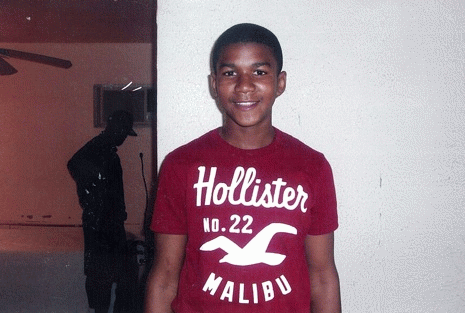The headline of a recent USA Today article reads, "In wake of Trayvon Martin's death, America is soul-searching" (1). And so it should be. He was a 17-year-old African-American walking back from a convenience store when he was gunned down by an overzealous and self-appointed neighborhood watch activist, George Zimmerman. The media has so far demanded that the public acknowledges that Martin was walking back to "a gated community" in Florida with Skittles in his pocket (2) (3) (4) (5) (6). The incident which occurred on February 26, just weeks after his 17th birthday, has sparked international outrage against racism and injustice. The boy was most likely racially profiled ("f*cking coons ") and murdered by a much larger, much older, and better equipped member of the community who, outrageously, has yet to be charged with a crime (7).
As a media sensation, the story has forced us to examine racial tensions and prejudices in post-Barack America as well as America's amorous relationship with firearms. It's a tragedy that reflects some of the uglier aspects of our culture. Benjamin Crump, the family's attorney, praised the media's role in revealing the facts surrounding the injustice: "Thank God for the media, because I'm not sure we ever would have gotten the truth out" (8). Indeed, the media revealed another illustrative aspect of this incident in an LA Times headline that read "George Zimmerman dreamed of being a cop" (4).
The connection between Zimmerman and law enforcement is a remarkable one when we examine another murder of a young African-American male right around the same time as Martin's death. On February 2, Ramarley Graham, 18-years-old, was shot to death while unarmed in his grandmother's Bronx apartment in the vicinity of his younger brother, 6-years-old (9). If you search his name on Google, you'll find that his murder was virtually neglected when compared to Martin's murder. Trayvon Martin has hour-by-hour coverage and a Wikipedia article. Ramarley Graham's has a handful of mentions by Huffington Post and NY times (10).
Why the disparity? Graham was killed by an NYPD police officer in the narcotics enforcement division. NYPD police commissioner Ray Kelly expressed his opinion at a subsequent press conference: "At this juncture we see an unarmed person being shot. That always concerns us" (9). You might be thinking, or perhaps hoping, that the facts reveal Graham to be somehow "less innocent" than young Martin with the Skittles in his pocket. Well, of the little bits of information that have been reported, most point to the fact that the police were acting on the suspicion that Graham "might have been armed" (11) (12). On this suspicion, they followed Graham as he walked into his grandmother's apartment. There's even a video that shows that Graham, indeed, walked into the apartment (13). The police, specifically Officer Richard Haste, eventually sprinted to the door, kicked it down, and shot the boy in the chest. Apparently, Haste "believed he was in mortal danger" (14).
What were the officers doing in the first place? They're instructed to make arrests upon witnessing a drug deal. Instead, they witnessed Graham emerge from a bodega with two friends. Apparently, "something about how he moved his hands near his waist led the officers to suspect he was armed" (11). He probably had that criminal sort of gait, presumably. Indeed, the surveillance video confirms hooded sweatshirt and baggy pants. Well that was it for Ramarley Graham. The NYPD was vindicated when they found a bag of marijuana in the toilet bowl next to the body.
Both deaths are deeply tragic and grievous. And neither takes away from the significance of the other. Each case reflects deep-seated forms of racist oppression against blacks in the U.S. Yet one has clearly become more sensational than the other. To find out why, we have to examine deeper differences that have yet to be addressed.
In Trayvon Martin's case, the mode of racism is horizontal in nature. Zimmerman, a self-appointed neighborhood watchman, acted on violent inclinations filtered through misguided and dangerous stereotypes. But both were more or less members of the same socioeconomic locale. Contrastingly, in Ramarley Graham's case, the injustice was vertical in nature. Officer Haste, serving in the War on Drugs--incidentally associated with what's called the New Jim Crow--was attempting to make a low-level marijuana arrest. Haste may or may not have been a parallel incarnation of Zimmerman, who "dreamed of being a cop." His gun, however, was issued to him by the city of New York. Furthermore, his neighborhood watch was not self-appointed; rather, it was authoritatively commanded.
The top-down institutional nature of the Graham tragedy makes it indirectly a class issue. Graham was targeted by the police because he was black and in the Bronx, hallmarks of the insurgent in the War on Drugs. However, class incongruities do not fit the narrative of the mainstream corporate-owned media. You're not supposed to think about institutional oppression. Bitterness and suspicion needs to be aimed around you, not above you. It's your neighbor that's bankrupting the country, stealing your job, and murdering children. Because of him/her, your gated community is no longer safe.
The juxtaposition of these two tragedies demonstrates how effectively the media can selectively channel righteous indignation in a way that serves elite interest. The murders of Graham and Martin are equally monstrous, but there's no question that a state-sponsored homicide is far uglier and more deeply unsettling than one committed by some local fanatic.
1) http://www.usatoday.com/news/nation/story/2012-03-20/trayvon-martin-teen-shot-stereotypes/53677634/1
2) http://www.guardian.co.uk/world/2012/mar/20/trayvon-martin-death-story-so-far?newsfeed=true
(Note: You can view every article as one long page if you sign up as an Advocate Member, or higher).





